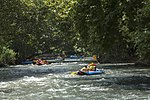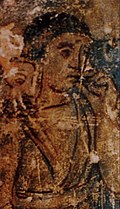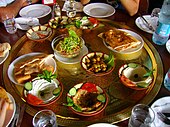Selected article 1
Portal:Jordan/Selected article/1

Petra was built by the Nabataeans, an ancient Semitic people, and is best known for the impressive stone structures such as the treasury (pictured) and the monastery which are carved into the rock in the ancient city. Petra today is a popular tourist site, and was declared a UNESCO World Heritage Site in 1985.
Selected article 2
Portal:Jordan/Selected article/2

Selected article 3
Portal:Jordan/Selected article/3 The University of Jordan is the largest and oldest state-supported institution of higher learning in Jordan. Established in 1962, it is considered one of the most prestigious universities in the Middle East. Located in the Amman university district of Jubaiha, the university employs over 1,400 staff and more than 37,000 students study there.
Selected article 4
Portal:Jordan/Selected article/4 The Disi Water Conveyance Project is a water supply project in Jordan. It is designed to pump 100,000,000 cubic metres (2.2×1010 imp gal) of water per year from the Disi aquifer, which lies beneath the desert in southern Jordan and northwestern Saudi Arabia. The water is piped to the capital, Amman, and other cities to meet increased demand. Construction began in 2009 and was mostly completed in July 2013 when the project was inaugurated by King Abdullah of Jordan. Its total cost was US$1.1 billion.
Selected article 5
Portal:Jordan/Selected article/5 Shabab Al-Ordon Club is one of the most successful association football clubs in Jordan. Founded only in 2002, Shabab Al-Ordon, nicknamed the Lions, nevertheless captured the 2007 AFC Cup, the second-tier Asian club continental cup, defeating compatriots Al-Faisaly in the process. The club was also one of the first football teams in the country to establish a women's team, and a number of the Jordan's women's national team players have played for the Lions.
Selected article 6
Portal:Jordan/Selected article/6

Selected article 7
Portal:Jordan/Selected article/7 Arab Bank is a bank headquartered in Amman. The first private sector bank in the Arab World, Arab Bank was founded in 1930 in Jerusalem and in 1964 was the first Arab bank to open a branch in the banking hub of Switzerland. Today, the company represents approximately 25% of the Amman Stock Exchange and has locations in several different international locations including Frankfurt, London, and Singapore.
Selected article 8
Portal:Jordan/Selected article/8

Jordanian art has a very ancient history. Some of the earliest figurines, found at Aïn Ghazal, near Amman, have been dated to the Neolithic period. A distinct Jordanian aesthetic in art and architecture emerged as part of a broader Islamic art tradition which flourished from the 7th-century. Traditional art and craft is vested in material culture including mosaics, ceramics, weaving, silver work, music, glass-blowing and calligraphy. The rise of colonialism in North Africa and the Middle East, led to a dilution of traditional aesthetics. In the early 20th-century, following the creation of the independent nation of Jordan, a contemporary Jordanian art movement emerged and began to search for a distinctly Jordanian art aesthetic that combined both tradition and contemporary art forms.
Selected article 9
Portal:Jordan/Selected article/9 The Parliament of Jordan is the bicameral Jordanian national assembly. Established by the 1952 Constitution, the legislature consists of two houses: the Senate ("Majlis Al-Aayan") and the House of Representatives ("Majlis Al-Nuwaab").
The Senate has 65 members, all of whom are directly appointed by the King, while the House of Representatives has 130 elected members, with nine seats reserved for Christians, three are for Circassian and Chechen minorities, and fifteen for women.[1] The members of both houses serve for four-year terms.[2]
Selected article 10
Portal:Jordan/Selected article/10

Jordanian cuisine is part of Levantine cuisine and shares many traits and similarities with the cuisine of Lebanon, Palestine and Syrian, often with some local variations. More generally Jordanian cuisine is influenced by historical connections to the cuisine of Turkey and the former Ottoman Empire. Jordanian cuisine is also influenced by the cuisines of groups who have made a home for themselves in modern Jordan including, Armenians, Circassians, Iraqis, Palestinians, Syrians.[3][4]
Food is a very important aspect of Jordanian culture. In villages, meals are a community event with immediate and extended family present. In addition, food is commonly used by Jordanians to express their hospitality and generosity. Jordanians serve family, friends, and guests with great pride in their homes; no matter how modest their means. A 'Jordanian invitation' means that you are expected to bring nothing and eat everything.
Selected article 11
Selected article 12
Selected article 13
Selected article 14
Selected article 15
- ^ "The World Factbook — Central Intelligence Agency". www.cia.gov.
- ^ "World Factbook: Jordan", U.S. Central Intelligence Agency
- ^ "The Flavors of Jordan". Archived from the original on 2015-09-10. Retrieved 2015-10-28.
- ^ "the tanjara: book on jordanian food". thetanjara.blogspot.nl. Retrieved 2015-10-28.